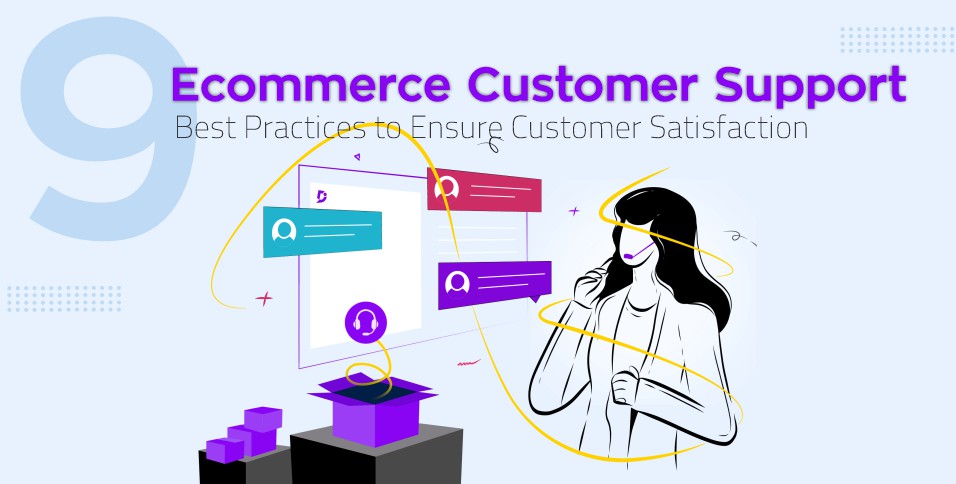In today’s fast-paced world, businesses need to be savvy and responsive to customer concerns.
Customer support plays a vital role in the success of your business, especially if it’s an ecommerce store.
Online shopping has been gaining ground in recent years with tremendous strides.
In fact, there are currently more than 263 million digital shoppers in the United States. That number is expected to climb even higher.
So, if you want to compete in such a vast marketplace, it pays to ramp up the level of customer support you offer.
My name is Omar Deryan, CEO at OJDS. I have worked with over 3000 e-commerce sellers over the past 5 years.
And in this article, I’m going to share with you the best 9 customer support practices to ensure your customers keep coming back.
Let’s get started.
What is Ecommerce Customer Support?
Simply put, customer support is centered around providing technical assistance to customers with issues regarding your products or services.
This can involve various tasks like troubleshooting, resolving errors, and other concerns related to product functioning.

Why Does Customer Support Matter?
Making sure customers are happy doesn’t end once they purchase your product.
Outstanding customer care involves staying responsive to their requests for after-sales assistance.
Unfortunately, while the internet has been the driving force behind the rise of ecommerce stores, it has also created a shift in customers’ expectations.
Online shoppers now expect fast and easy transactions and no waiting time as much as possible.
At the same time, they want personalized shopping experiences.
After all, consumers want to feel valued at the stores they buy from.
The significance of customer support and overall customer service cannot be overstated. The truth is that 95% of consumers consider it a major deciding factor in staying loyal to a brand.
No matter how exceptional your product is, any negative interaction can result in unhappy customers.
But when you go the extra mile and provide the support they need, they will be inclined to give positive feedback and referrals.
In a highly competitive digital market, that’s a huge advantage.
9 Best Practices to Ensure Customer Satisfaction
With this in mind, it’s clear that providing excellent customer support is one of the best strategies to stand out from the crowd. Here are nine tips to achieve this goal.
1. Be organized and consistent
An organized system is one of the first steps to achieving successful customer support.
You might have the best support team in the world, but responding to many customer concerns can be chaotic without organization.
Tools like response templates, collision detection, and a shared inbox boost collaboration within and between teams and get everyone on the same page.
This streamlines your customer support process, improving consistency and efficiency.
2. Develop a multi-channel strategy
One of the most important goals for businesses is to provide customers with a tailored approach that would make them feel valued.
It might be tempting to offer a one-size-fits-all solution, but unfortunately, there’s no such thing in ecommerce.
Some customers prefer communicating via phone calls, while others may want to send an email or use the live chat option.
They may also use social media and ask questions through platforms like Facebook, Instagram, Whatsapp, and Twitter.

No matter their preferences, you must be ready to meet them wherever they are. A practical way to do this is by using a multi-channel strategy.
This strategy combines platforms to ensure your customers can reach you conveniently. It allows you to serve more people across different channels.
When integrated with a helpdesk system, the process becomes even more seamless.
Stay connected to your customers through their preferred communication channel sends the message that you want them to feel comfortable.
3. Use chatbots for real-time and round-the-clock support
A chatbot is an automated program – a simulation of human conversation. The best chatbots for eCommerce businesses will be invaluable because they can provide real-time responses to customer queries 24/7.
Chatbots operate under pre-set rules and a knowledge base and offer scripted responses to customers based on their questions.
Since they are automated, they provide instant resolutions, reducing the waiting time on the customer’s end.
At the same time, they ease the workload on your team. They can divert up to 60% of incoming queries, leaving your agents with more time and energy for more complex issues.
4. Use Help Desk Software
Help desk software is a valuable solution for efficiently handling customer complaints and questions.
It’s a digital platform that converts support requests and issues into tickets.
Customer support agents can then track the progress of these tickets and ensure that the problems get resolved promptly. This fast-tracks the process and prevents customers from getting impatient or angry.
Aside from a ticketing system, a good help desk software also offers other features to help improve the overall customer experience.
Some examples are multi-channel integrations for better accessibility to customers and a feedback system that lets you make adjustments for positive customer interactions.
It’s important to get software that’s up to date and integrates seamlessly with your other tools.
That way, your customer support team won’t have to look for customer data in different systems to respond appropriately to queries.
The right helpdesk software unifies information and makes intelligent decisions for the support team, cutting down on response time.
5. Provide self-service-based ecommerce support
Giving customers a self-service option is more advantageous than you would expect. Surprisingly, many customers prefer to find resolutions on their own for simple matters.
They want to avoid the trouble of lodging a query and waiting for an answer.
A self-service support portal simplifies matters for both customers and the support team.
For example, an FAQ section or a knowledge base in which you publish answers to common questions cuts down on the customer’s waiting time and the volume of queries for the support team.
Make sure to review this section periodically to see if you need to update it or add more information.
This strategy’s key principle is minimizing customer effort, which leads to greater customer satisfaction.
That said, some situations call for a more personalized approach, which leads us to our next point.
6. Aim for a balance between automation and personalization
Smart business owners know that customer support needs to strike the right balance between automated processes and human interaction.
While it’s not realistic to run a company without automation, it does pay to offer truly personalized support when necessary.
Too much automation can be unproductive if the customer is trying to resolve a complex issue.
A more nuanced way to balance these two aspects is to use technology to provide meaningful interactions. For example, agents can guide or assist customers through a live chat feature.
This hits two goals at once: it gives the customer a real conversation with another person and makes the process more efficient for the company.
7. Leverage customer reviews
Like any regular store, ecommerce businesses rely heavily on customer reviews to stand out and build a strong brand.
Giving customers a space to leave their opinions about your product or service makes them feel heard.
It can also help them view your brand in a favorable light.
After you’ve resolved their concerns, take the time to ask customers if they are satisfied with the resolution you’ve provided. You can do this simply by following up or asking them to fill out a feedback form.
Social media can also serve as a rich source of customer feedback for your online store.
Whether negative or positive, feedback can provide valuable insights to help improve customer service.
Many business owners take this opportunity to learn more about what sits well with their customers and what aspects they need to adjust.
8. Improve response time
This is something that bears repeating – customers want their concerns to be addressed promptly.
The more complicated your customer support process is, the more likely they are to walk away with a negative impression.
You may have multiple channels through which they can contact you, but if your team does not respond quickly, the customer would feel frustrated just the same.
It’s essential to achieve a balance between convenience and speed.
9. Be proactive – measure, optimize, repeat
Lastly, constant evaluation is crucial to an exceptional support system.
Online businesses must proactively and consistently review their customer support processes to maintain customer satisfaction.
Look at metrics that measure your overall customer support performance, such as average response time, resolution time, the quality of support, and resolved queries.
These data will show you any lapses that you need to address. That way, you can resolve issues in a timely and flexible manner.
Take Your Customer Support System to the Next Level
When done right, customer support can ensure customer satisfaction and set you apart from your competitors.
With today’s customers having higher expectations for their online shopping experiences, companies would do well to be as responsive as possible.
Investing in the best ecommerce platform for small business will speed up your response times and help you manage customer queries efficiently.
Not only will this lead to happy customers, but it will also help you acquire new ones.
Also Read: 4 Proven Strategies To Improve And Grow Your eCommerce Apparel Business
















